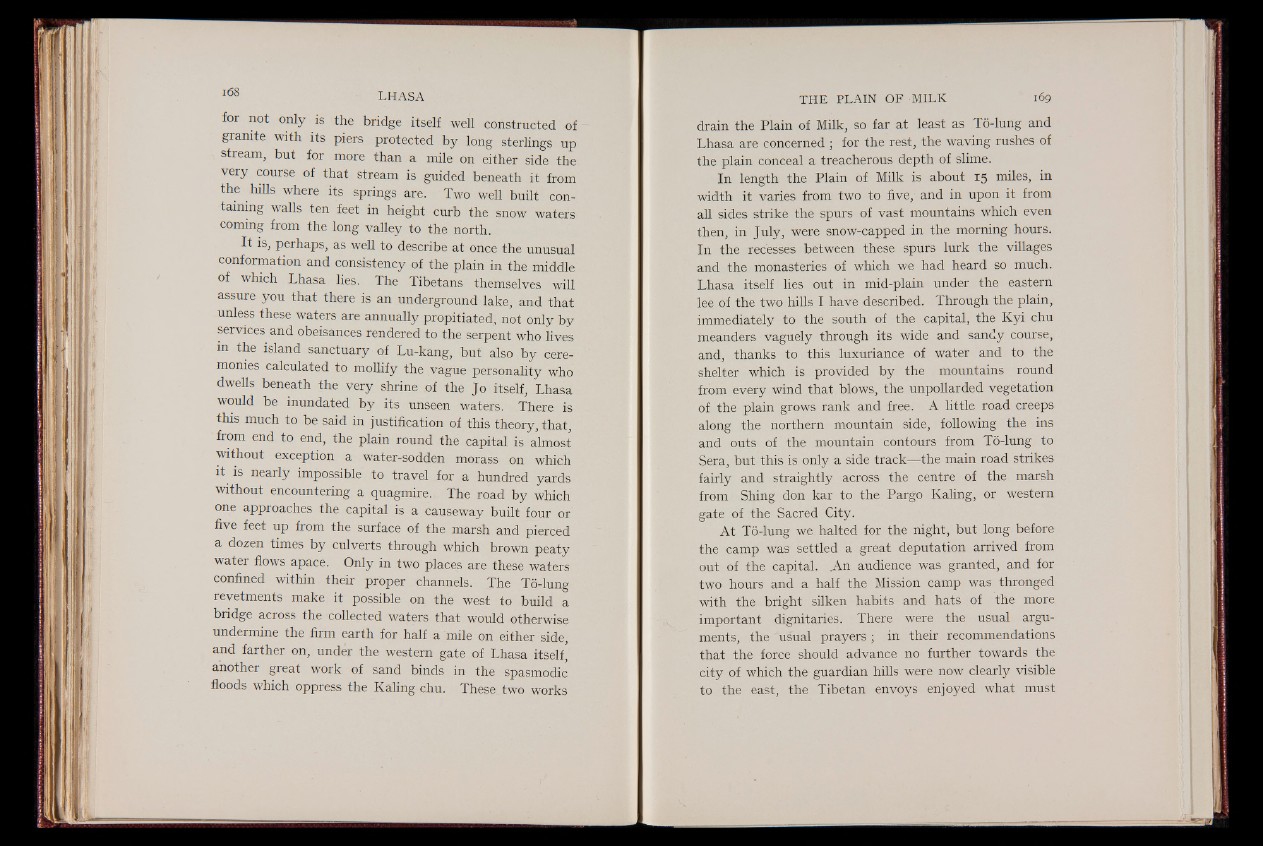
for not only is the bridge itself well constructed of
granite with its piers protected by long sterlings up
stream, but for more than a mile on either side the
very course of that stream is guided beneath it from
the hills where its springs are. Two well built containing
walls ten feet in height curb the snow waters
coming from the long valley to the north.
It is, perhaps, as well to describe at once the unusual
conformation and consistency of the plain in the middle
of which Lhasa lies. The Tibetans themselves will
assure you that there is an underground lake, and that
unless these waters are annually propitiated, not only by
services and obeisances rendered to the serpent who lives
m the island sanctuary of Lu-kang, but also by ceremonies
calculated to mollify the vague personality who
dwells beneath the very shrine of the Jo itself, Lhasa
would be inundated by its unseen waters. There is
this much to be said in justification of this theory, that,
from end to end, the plain round the capital is almost
without exception a water-sodden morass on which
it is nearly impossible to travel for a hundred yards
without encountering a quagmire. The road by which
one approaches the capital is a causeway built four or
five feet up from the surface of the marsh and pierced
a dozen times by culverts through which brown peaty
water flows apace. Only in two places are these waters
confined within their proper channels. The To-lung
revetments make it possible on the west to build a
bridge across the collected waters that would otherwise
undermine the firm earth for half a mile on either side,
and farther on, under the western gate of Lhasa itself,
another great work of sand binds in the spasmodic
floods which oppress the Kaling chu. These, two works
drain the Plain of Milk, so far at least as To-lung and
Lhasa are concerned ; for the rest, the waving rushes of
the plain conceal a treacherous depth of slime.
In length the Plain of Milk is about 15 miles, in
width it varies from two to five, and in upon it from
all sides strike the spurs of vast mountains which even
then, in July, were snow-capped in the morning hours.
In the recesses between these spurs lurk the villages
and the monasteries of which we had heard so much.
Lhasa itself lies out in mid-plain under the eastern
lee of the two hills I have described. Through the plain,
immediately to the south of the capital, the K yi chu
meanders vaguely through its wide and sandy course,
and, thanks to this luxuriance of water and to the
shelter which is provided by the mountains round
from every wind that blows, the unpollarded vegetation
of the plain grows rank and free. A little road creeps
along the northern mountain side, following the ins
and outs of the mountain contours from To-lung to
Sera, but this is only a side trackBThe main road strikes
fairly and straightly across the centre of the marsh
from Shing don kar to the Pargo Kaling, or western
gate of the Sacred City.
At To-lung we halted for the night, but long before
the camp was settled a great deputation arrived from
out of the capital. .An audience was granted, and for
two hours and a half the Mission camp was thronged
with the bright silken habits and hats of the more
important dignitaries. There were the usual arguments,
the usual prayers; in their recommendations
that the force should advance no further towards the
city of which the guardian hills were now clearly visible
to the east, the Tibetan envoys enjoyed what must